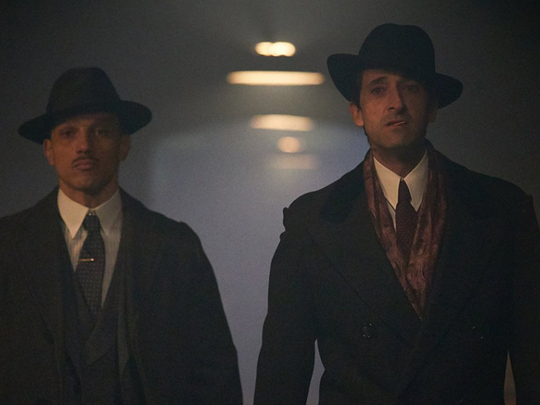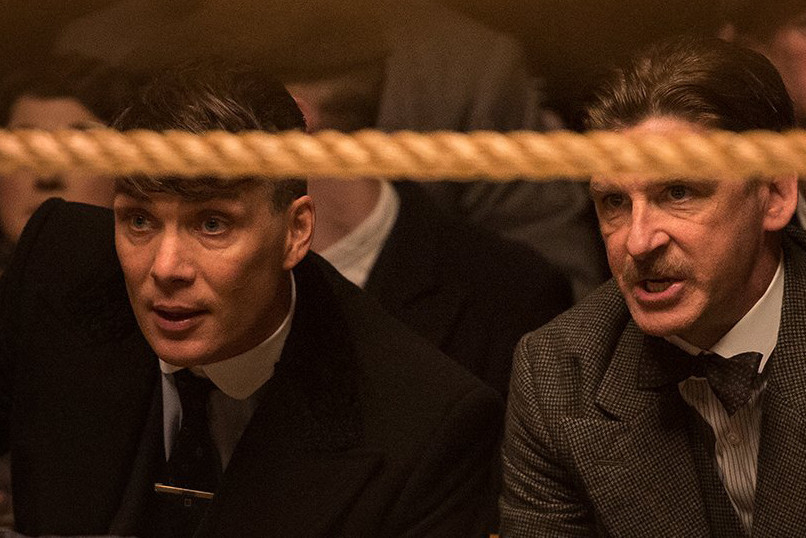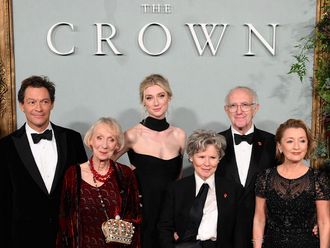
Peaky Blinders has become a cult hit for the BBC and Netflix, drawing famous fans like David Bowie and Leonard Cohen, who each offered songs for its soundtrack, and style disciples inspired by its story of a natty and ruthless Birmingham crime family in the era between the world wars. Its fourth season began on Thursday on Netflix (it already ran on BBC Two), with the gang, led by Cillian Murphy’s icy Tommy Shelby, getting into the fight game. So the Olympic has been transformed into a 1920s boxing arena complete with vintage posters and an enormous Union Jack. It filled up with herbal cigarette smoke and stylish overcoats as a foghorn-voiced sidekick commanded a few dozen extras to step right up for an audience with “the Peaky” [expletive] “Blinders!” It’s a phrase fans tend to shout with glee and a bad brummie accent, no matter where they’re from. Such is the infectious allure of this series, the top-rated drama on BBC Two — Netflix doesn’t release viewing data — with a pop culture impact that, a la shows like Mad Men, arguably outpaces the numbers. In England, there are Peaky Blinders bars, restaurants, tours, parties and weddings. The distinctive undercut hairstyle went from the bane of the actors to the subject of how-to articles in men’s magazines, and the popularity of the show’s slick early 20th-century tailoring led its creator, Steven Knight, to partner on a Peaky clothing line. “To influence people — not people involved in the industry but real people who watch TV and then go out and do something about it — it’s great,” Knight said. As a primarily Roma group in Birmingham, the Peakies are a departure from the usual pop culture gangsters. The new menace — a New York-based Mafioso with a grudge played by Adrien Brody — represents the first time they will tangle with the more classic version. The Shelby family, which also includes Aunt Polly (Helen McCrory) and Tommy’s brothers Arthur (Paul Anderson) and John (Joe Cole), has been arcing toward respectability, but the new threat will force them to return to the old neighbourhood. “The whole series is about escape, with a particularly British point of view: Can you escape where you’re born?” said Knight, who writes every episode.
“Season four is a very literal pulling back of the entire family to where they’re from, so they can re-evaluate who they are in the environment they once were in.” But while it deals in a specifically British theme, Peaky Blinders does so with an amalgam of disparate influences and elements — American westerns, a lithe Irish actor playing a tough crime boss, an art punk soundtrack — that add up to an arresting whole. Peaky Blinders was born from the stories Knight heard about his father’s uncles, members of the real Peaky Blinders gang in Birmingham. The name came from the members’ signature flat-caps that became “blinders,” the probably apocryphal story goes, when weaponized with razor blades sewn into the peaks. The stylised look and feel — the dazzling suits, the cathedral-like neighbourhood pub, the slow-motion shots of the gang swaggering through grimy streets — is designed to approximate the wonder Knight felt upon hearing these marvellous tales while growing up in that city. “The horses are bigger and blacker; the men are stronger and more rugged; the women are more glamorous; the lipstick’s brighter,” McCrory said. “It’s almost like a graphic novel.” Although it’s a crime show, Peaky Blinders was inspired by American westerns, specifically the way they turned what was fundamentally “19th-century agricultural labour” into a heroic genre full of chivalry and myth. “I wanted to apply that sort of boldness to the city where I came from and my parents’ family,” Knight said. “It’s a good way into history because it’s through the imagination and the feeling, rather than through the bricks and mortar of it.” Caryn Mandabach, an executive producer, couldn’t see the slender Murphy as an imposing crime boss. Until she met him. “He was so powerful in the room that it didn’t matter that he was physically not a big guy,” she said. Decked out in “Peaky” wear — robin’s-egg shirt, charcoal vest and gold-chain sleeve garters — Murphy does look smaller in his trailer than he had on the monitors minutes before, although he has a coiled physicality and the actor’s gift of filling a room with his presence. Since emerging in the 2002 zombie thriller 28 Days Later, Murphy had become best known for roles in indie films like The Wind That Shakes the Barley as well as Christopher Nolan movies like The Dark Knight and Inception. But he noticed the more ambitious storytelling happening on TV and asked his agent to “put the word out that I’m interested,” he said. “Two days later, I read the first two episodes of ‘Peaky Blinders’ — it was serendipity, you know what I mean?” As the anchor of the Shelbys and the show, Tommy displays the classic contradictions of the gangster anti-hero — a family man who murders without compunction. But in his case the dissonance has a specific source: his time in the First World War, which physically and emotionally decimated a generation of Europeans. “I wanted Cillian to encapsulate that closed-down, totally war-damaged male that shows no emotion,” Knight said. The core relationship of the show is between Tommy and McCrory’s Polly, who comes somewhat undone in Season 4 but remains Tommy’s most trusted ally. The dynamic is emblematic of the show’s strong female roles, a rarity in gangster dramas. “I always find it surprising when that gets commented upon,” Knight said. “In any family that I’ve ever come across, the females are dominant. They just are.” The signature “Peaky” cut, high and tight, with the sides shaved every couple of days, initially “horrified” the actors, Knight said. The style was inspired by the First World War cuts favoured by infantrymen to discourage lice — now “footballers in England with multimillion-pound contracts are having them,” he said. Within the show, the most striking aesthetic element is the charged and often surprising soundtrack, an anachronistic mix of modern rock and punk with quieter, brooding works along the lines of its sinister theme song, Red Right Hand by Nick Cave and the Bad Seeds. The tracks suggest the seething emotion beneath Tommy’s placid exterior — Nick Cave “is Tommy’s spirit animal,” Mandabach said — and the soundtrack benefits from the fact that Peaky Blinders is popular among musicians. Bowie sent a picture of himself in a Peaky style flat cap and arranged not long before his death for the show to use one of his songs; “Lazarus,” from his final album “Blackstar,” appeared in an episode last season. And other acts who rarely license their music, like Radiohead and PJ Harvey, have allowed their work to be used in the series. (Some music doesn’t appear in the Netflix version for licensing reasons.) Antony Genn, the show’s composer and a former member of the English rock band Pulp, joined the show this season and has placed more emphasis on original recordings featuring “my talented friends who are also outlaws,” like Flea, Iggy Pop and Jarvis Cocker. The focus on new music dovetails with arguably the most curious Peaky brand extension yet: a musical that Knight has proposed as the next era of the Shelby story, once the TV series wraps up. (He said Season 5 would probably be the last one.) “We’ve been approached by some very reputable people who have said this is perfect for a musical, so who knows?” he said. “That’s the least likely thing with Peaky Blinders, so that’s what we’ll probably do.”
___
Don’t miss it
Peaky Blinders is now streaming on Netflix.














